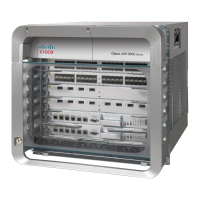123
Cisco ASR 9000 Series Aggregation Services Router Getting Started Guide
OL-28417-02
Chapter CLI Tips, Techniques, and Shortcuts
Displaying System Information with show Commands
Displaying Subnet Mask in CIDR Format
This feature displays IPv4 address subnet mask in Classless Interdomain Routing (CIDR) format instead
of decimal format. The change of format for all show commands may cause backward compatibility
issues. To overcome this problem, the ipv4 netmask-format hit-count command has been implemented
in the IP/CLI component, which maintains the common infrastructure specific to IP related CLIs.
To display the subnet in a prefix length format, you need to configure the ipv4 netmask-format
hit-count command at the global configuration mode:
RP/0//CPU0:router# configure terminal
RP/0//CPU0:router(config)# ipv4 netmask-format bit-count
RP/0//CPU0:router(config)# commit
RP/0//CPU0:router(config)# end
After this command has been configured, the output of the show command forcefully displays the subnet
mask in a prefix length format. Also, you can disable the command by using the no form of the
command.
RP/0//CPU0:router# no ipv4 netmask-format bit-count
RP/0//CPU0:router#
Note This ipv4 netmask-format hit-count command is supported only in the configuration mode.
The following example shows the output of a show running-config command after the ipv4
netmask-format bit-count command has been configured:
RP/0//CPU0:router# show running-config interface mgmtEth 0/RP0/CPU0/0
Mon May 31 23:48:17.453 DST
interface MgmtEth0/RP0/CPU0/0
description Connected to Lab LAN
ipv4 address 172.29.52.70 255.255.255.0

